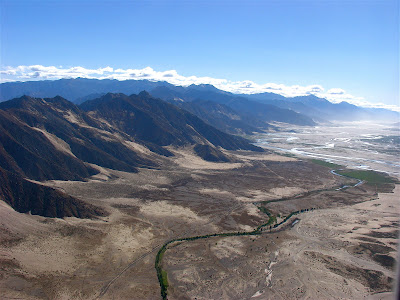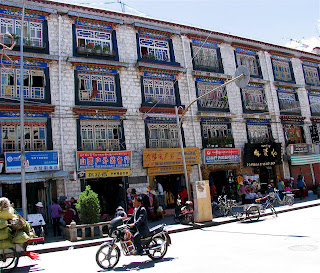


Photos above: The flight into Lhasa is famously spectacular with views to the snow capped Himalayas in the distance and the rugged, rocky dry mountains that line the valley. The valley itself is actually a riverbed and in the summer, it swells with water that in some places is up to a mile wide.
I went to Central Tibet in search of my inner Buddha and I found a Chinese Disneyland instead. My response was conflicted, ranging from anger to repulsion, disappointment to sadness. I arrived in Lhasa expecting to witness the very essence of the Dalai Lama, to spiritually sense the manifestation of the Buddha of compassion. But the Chinese have made it a challenge, having all but eradicated Tibet from its own land, destroying 99% of its religious buildings during the Cultural Revolution, connecting Tibet to China via highways and high speed rail, building pagoda roofs atop traditional Tibetan homes and lining city streets with a maze of Chinese style garage fronts and kiosks operated by government subsidized Chinese émigrés who sell souvenirs of the very culture their government has worked so diligently to destroy.
Despite this harsh reality, Tibet remains defiantly and indisputably alive in its people, its pristine and truly remarkable environment and in its peaceful traditions. Less than 60 years ago, Tibet was for those outside of it, a mysterious and exotic land intentionally isolated from the world. Its altitude and its desolate climate is why it is still referred to as “The Roof of the World” and why in places, it feels like the moon, or at least the end of the earth. It is at once extraordinary and utterly unique and looking back on the experience, I am reminded that it will take far more than a “China” designation on a world map to erase this beautiful country, culture and people. At its core, Tibet is still and will forever be the true manifestation of the Buddha. You have only to look in your own heart to recognize it.
I wrote that on my flight home to the States. I was trying to reconcile my love for Tibetan culture, spirituality, faith and family with what their country has been transformed into under the Chinese occupation. Tibet isolated itself because of its faith and because of its faith, it could not defend itself against its oppressors. It remained steeped in the past and in tradition rather than embracing new technologies designed to make life faster rather than simpler. This is understandable to me. I mean, how do you achieve detachment in the modern world which is defined by what is outside us rather than living within? The Dalai Lama understood the need to modernize and introduce Tibet to the world at large. While he may have come to age too late for Tibet the land, he was right on time for Tibet the people, who continue to revere and love him from all over the world.
Years ago, my Dad took me and my sisters Karen and Julie on a vacation to Ixtapa, Mexico. It was a new resort at that time and expected to become the next Acapulco or Puerto Vallarta. At that time, my Dad spent a lot of time in Mexico because of his International role with the West Company so he had a lot of friends and colleagues all around the country. Plus he really dug Latin culture in general. He used to listen to sambas ("do you like to samba, yes I do, do you like to samba, yes I do") and salsa music and we shared a love for Herb Albert and the Tijuana Brass. Anyway, while we were at the beach resort, it was my father who ironically was the one of us to come down with Montezuma's Revenge which resulted in his spending much of his vacation miserable and in his room. When he was finally feeling better, we dragged him along with us into Zihuatanejo to a great pizza place we had found. As we were walking around town buying papier mache animals and taking pictures, Julie, Karen and I were very excited. We loved it there - so colorful and different than Villanova, Pa! So we turned to Dad and asked eagerly, "What do you think?" His response was, and I quote: "Just another stinking Mexican shithole."
When we first stepped out onto the street in Lhasa, I looked around, took a couple of shots (below) and thought with such sadness to myself, "just another stinking Chinese shithole."


After a delicious Nepalese lunch, we headed over to the Jokhang Temple, the most revered religious structure in Tibet. The square before it features prayer poles with prayer flags wrapped around them
 and incense burners. Note: The photo of Jokhang Square, above, was taken from the roof of the temple. You can see the Potala in the upper right. There is a constant stream of pilgrims at Jokhang, but today is especially busy due to an upcoming auspicious day of the year. There are many people seated in prayer and spinning hand held prayer wheels as well as those who prostheletize themselves before the Temple.
and incense burners. Note: The photo of Jokhang Square, above, was taken from the roof of the temple. You can see the Potala in the upper right. There is a constant stream of pilgrims at Jokhang, but today is especially busy due to an upcoming auspicious day of the year. There are many people seated in prayer and spinning hand held prayer wheels as well as those who prostheletize themselves before the Temple.  All around the square are pilgrims circumambulating the Jokhang's outer walls, known as the Barkhor. At the front door of the Temple, there is a large Stele
All around the square are pilgrims circumambulating the Jokhang's outer walls, known as the Barkhor. At the front door of the Temple, there is a large Stele  which is inscribed with the terms of the Sino Tibetan Treaty of 822 which guarantees a mutual respect of the borders of China and Tibet.
which is inscribed with the terms of the Sino Tibetan Treaty of 822 which guarantees a mutual respect of the borders of China and Tibet. The building before the Temple houses an altar pertpetually flickering with yak butter candles.
 The Jokhang was founded by King Songtsen Gampo in 639 to house a Buddha image called Mikyoba, which was brought to Tibet as part of the dowry of his Nepalese wife Princess Bhrikuti. It was completed in 647. Tibet's most revered Buddha image is called Sakya Thukpa and was brought to Tibet by King Gampo's Chinese wife, Princess Wengcheng. It was moved to Jokhang to protect it after King Gampo's death. It is said that Princess Wengcheng chose the sight of Jokhang, which was once a lake known as Lake Wothang. While the lake was filled in, it is said that a well in the precincts of the temple still draws its water from those of the old lake. Over the centuries, Jokhang has undergone many renovations but the basic layout is ancient and differs from many other Tibetan religious structures, most notably by its east-west orientation. This was said to have been done in order for the temple to face toward Nepal in honor of Queen Bhrikuti.
The Jokhang was founded by King Songtsen Gampo in 639 to house a Buddha image called Mikyoba, which was brought to Tibet as part of the dowry of his Nepalese wife Princess Bhrikuti. It was completed in 647. Tibet's most revered Buddha image is called Sakya Thukpa and was brought to Tibet by King Gampo's Chinese wife, Princess Wengcheng. It was moved to Jokhang to protect it after King Gampo's death. It is said that Princess Wengcheng chose the sight of Jokhang, which was once a lake known as Lake Wothang. While the lake was filled in, it is said that a well in the precincts of the temple still draws its water from those of the old lake. Over the centuries, Jokhang has undergone many renovations but the basic layout is ancient and differs from many other Tibetan religious structures, most notably by its east-west orientation. This was said to have been done in order for the temple to face toward Nepal in honor of Queen Bhrikuti.
No comments:
Post a Comment